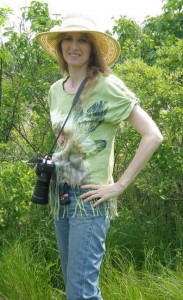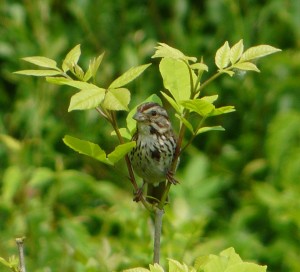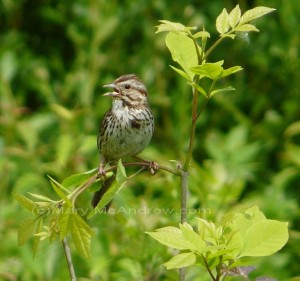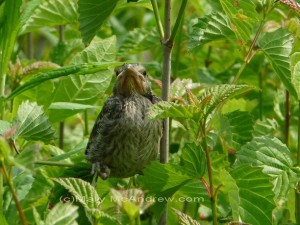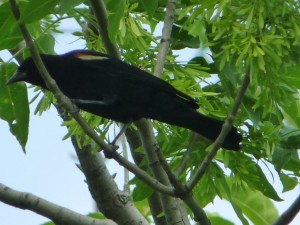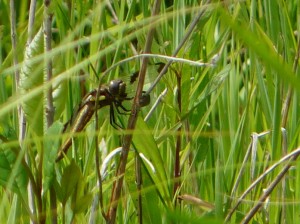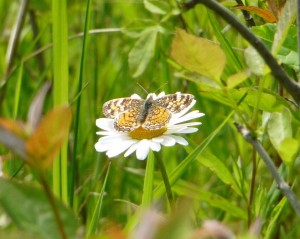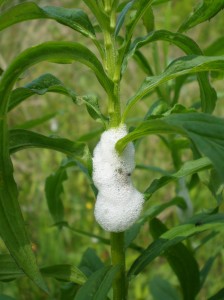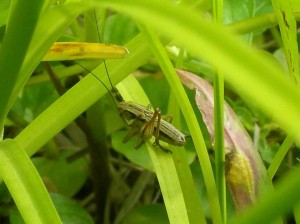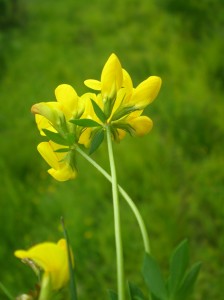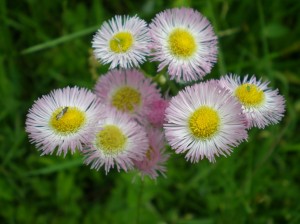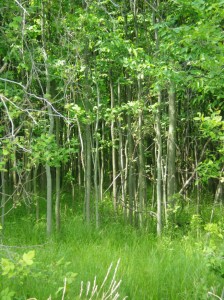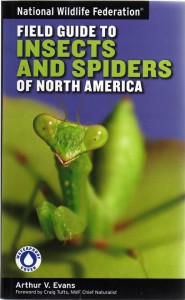The day was gorgeous, it was flying by too quickly while I worked inside, longing looks out over my field. Finally I grabbed my cameras, sun hat and rubber mud boots and said “That’s it! Let’s go for a walk Ginger!” Ginger goes nuts of course at the word ‘walk’; I feel relief already and a whole new energy coming in as we leave the yard behind. Sometimes it’s good to not plan, I’m an over planner. Having a field sketching kit ready to grab at a moments notice or your camera and extra battery ready is all you need.
Here I have my new favorite camera slung across my body, I find if you let the strap out all the way carrying it this way is less stress on your neck. I usually walk with the lens cover off, tucked into my back pocket. It’s ready to slip on if I go through brush or kneel down to investigate something where tall ‘stuff’ can scratch the lens. The camera is a Panasonic Lumix DMC-FZ28; I have an adapter on it so I can use that big Teleconversion Lens. Everything I shoot is hand-held so when I get clear shots I’m so happy, I just can’t set up a tripod while birding, bugging etc. but all the years of birdwatching comes in handy as I find it easy to spot and zoom on just the right area. The other little camera you see on my belt loop I find to be such a help and compliment to using the big lens, it’s an olympus FE 230 and I love it to peices! It’s great at taking super up close pictures and little movie clips. The movie clips on this blog are all mostly taken with it. (If you want to see all posts with clips, go to my Catagories list and click “Video Clips”) I took this pic by balancing the Olympus camera on a fence and used the timer…it’s a blast to take pics of yourself while out hiking. You are there in your element, why shouldn’t you remember that great big smile on your face?
The first exciting thing was spotting this male Song Sparrow, he was constantly perched about the tops of these small bushes in the middle of my field, around 40 feet away. I took snap after snap of one of my favorite little sparrows, I can’t wait to do a painting of him.
I point out here, he was not singing but constantly giving that little “CHIP” call they do when disturbed. Being that I was nowhere near him, I thought maybe he had a nest over there. BUT…..
Look what I saw as I turned to go…just down in the bushes right near me was a fledgling song sparrow! He was hot out of the nest I presume and sitting still as a statue. NOW I knew why the male Song Sparrow was calling. I carefully took slow steps all around the baby and took pictures, I had to move back a few steps in fact because of that long zoom lens I had. I also whipped out my little Olympus and took some snaps then after I was sure I had captured his mug for posterity from all angles, (picture me creeping around him step by step through heavy brush) I shot a short video clip of him (find it at the end of this post!).
Moving on. A male Red Winged Blackbird was scolding from way up high in a seed laden tree as Ginger wandered beneath him, not noticing. Then I turned my attention to what was below in the grasses and shrubs. I didn’t need to go far today to find a myriad of wonders. When you go into a field next, just stand still and start to count the number of things you notice; bend down and move some grasses and see what bugs you surprise.
I love Dragonflies, did you know they’ve been around since the time of the dinosaurs? This is a female 12 Spotted Skimmer, each of it’s four wings has three spots, do the math and you get twelve! That’d be great for a math lesson…3×4=12. The female has yellow lines on her sides and black spots on the wings, the male has black and white spots and a pale blue abdomen. If I hadn’t caught a photo of her, I’d never have identified what it kind it was later. It was difficult to catch her though, she flew, landed and disappeared each time; I had to point at where I ‘thought’ she went and zoom in hoping to find her…well you can see I did.
I still need to identify this butterfly I think it’s a ….. What a perfect shot to show how the butterflies coloring and pattern help to protect it. He’s poised on a daisey to feed, notice the color of his back wings (‘hind wings’) match the color of the flower center. Then in his forwings you see little marks of white that make a stripey pattern, just like the petals! If you start to question why something behaves the way it does, or looks the way it does, you’ll find nature around you to be immensely more interesting! And if your and artist, studying these details even if you don’t paint them, helps in understanding your subject.
Here’s a what’s either a Yellow-collared Scape Moth or a Grapeleaf Skeletonizer. I’ve seen these around the yard over the years and never paid much attention to them. Now I look closer at everything since I’ve started Nature Sketching. I would never have known this was a moth, as I went back to study him further I found two species that look similar. Time to call in reinforcements on this ID!
Next we have the unromantic Spittlebug! I have to further investigate further to see if it’s a ‘Two Lined’ or a ‘Meadow’ Spittlebug. I learned this one when I was in girl scouts, away back when. Funny thing is, in England I found out they call it “Cukoo Spit” because it appears around the time the Cukoos come back in Spring! At the center of this mass of ‘spit’ bubbles is a larvae that surrounds itself like this while feeding. The adult feeds on the sap of grains and grasses.
I never would have seen this little guy if I wasn’t poking around in the grasses looking at Spittlebugs! For a grasshopper he’s handsome and trim..haha..if one can describe a grasshopper that way. If anyone knows what kind it is I’d love to know, I am not versed in grasshopper! I had a good look through my “Feild Guide to Insects and Spiders of North America” (National Wildlife Fed.) and couldn’t find one just like it. Notice the leaf next to him to the right, it’s dying off and looks as though there may be eggs laid underneath? Interesting to note the color, it changed to a Cadmium Yellow to a rosy pink (Alizarin Crimson would work nice here). There is new fresh life and at the same time decay supporting more life all around us. It’s just nature’s natural cycle.
I now turn my attention to the beautiful wildflowers in the grasses. This is Bird’s Foot Trefoil, leaves in threes (‘tre’) and named Bird’s Foot because the flowers form a cluster of five at the top, when they turn to seed pods it looks like a birds toes.
This is Daisy Fleabane, my “Readers Digest Guide to Wildflowers” says that it was once hung in houses to help rid them of fleas! Most people would look at these popping up in thier gardens as weeds, but there are really pretty. They grow with the blossoms in clusters at the top of a delicate stem. As I took this photo I was returning from my hike with Ginger down “Pasture Lane”, the grass is very long and it’s shady and right next to a ditch of water, a perfect breeding ground for mosquitoes! They came up in clouds around me but I still nabbed this photo with my tiny Olympus camera…taking some bites on my arms! OUCH! One insect I don’t enjoy studying!
And we end here, looking into the deep woods. This scene is the type that inspired my paintings like “Mystic Woods”, “Secret Woods”, and “Raven Sphere”, see them in my Fantasy Gallery.
I promised a video clip…it was too big to upload, I’ll learn how to resize it then add it here! Sorry, it’ll come!
Below are the field guides I referred to, both are great!
